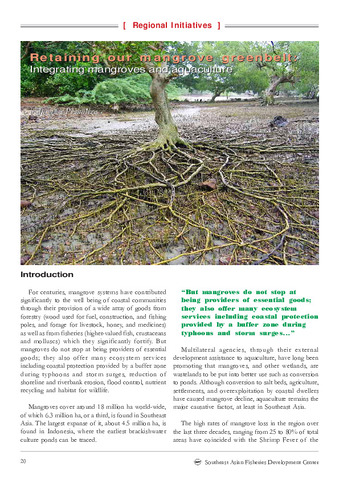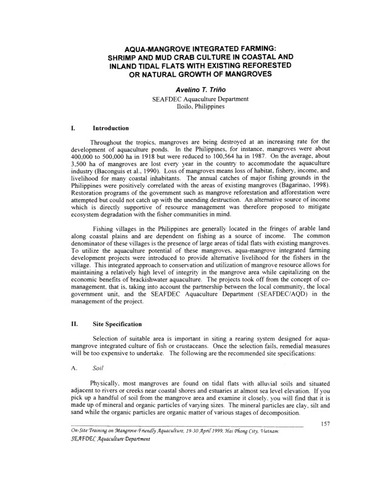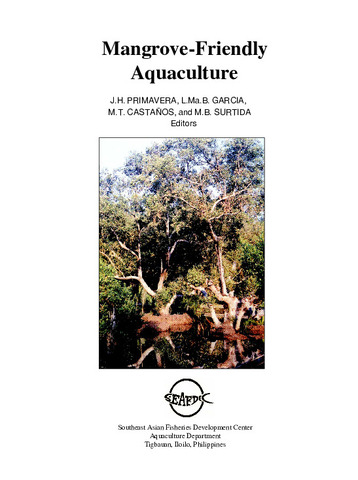Retaining our mangrove greenbelt: Integrating mangroves and aquaculture
- Global styles
- MLA
- Vancouver
- Elsevier - Harvard
- APA
- Help

View/
Date
2004Author
Page views
2,892ASFA keyword
AGROVOC keyword
Metadata
Show full item record
Share
Abstract
Although multilateral agencies in Southeast Asia have long been promoting that mangroves, and other wetlands, are wastelands to be put into better use, such as conversion to ponds. However, there is a need for Mangrove Friendly Aquaculture (MFA) technology in the intertidal forest, or swamp, which does not require the clearing of trees. MFA may be defined on 2 levels: 1) silvofisheries or aquasilviculture, where the low density culture of crabs, shrimps and fish is integrated with mangroves; and, 2) mangrove filters where mangrove forests are used to absorb the excess nutrients in the effluents from high-density culture ponds. A review is made of MFA practices belonging to the first category. Discussion is on a country basis, moving from traditional systems in Indonesia, to the introduced technologies in Indonesia, Vietnam, the Philippines and Malaysia. It is hoped that this review will be of use to scientists, aquaculturists, policy makers and governmental/NGOs interested in making aquaculture more ecologically sound and socially responsible.
Suggested Citation
Primavera, J. (2004). Retaining our mangrove greenbelt: Integrating mangroves and aquaculture. Fish for the People , 2(3), 20-26. http://hdl.handle.net/20.500.12066/694
Type
magazineArticleISSN
1685-6546Collections
- Fish for the People [41]
Related items
Showing items related by title, author, creator and subject.
-
Aqua-mangrove integrated farming: Shrimp and mud crab culture in coastal and inland tidal flats with existing reforested or natural growth of mangroves
Triño, Avelino T. (Aquaculture Department, Southeast Asian Fisheries Development Center, 2000)Throughout the tropics, mangroves are being destroyed at an increasing rate for the development of aquaculture ponds. In the Philippines, for instance, mangroves were about 400,000 to 500,000 ha in 1918 but were reduced ... -
Technologies in Mangrove-Friendly Aquaculture. Final Report of and Papers Presented to the On-Site Training on Mangrove-Friendly Aquaculture, Hai Phong City, Socialist Republic of Vietnam, 19-30 April 1999
Southeast Asian Fisheries Development Center, Aquaculture Department; Tadokoro, Yasuho; Sulit, Virgilia T.; Abastillas, Rosario B. (Aquaculture Department, Southeast Asian Fisheries Development Center, 2000)This document contains the final report of and papers presented as lecture materials, to the On-Site Training on Mangrove-Friendly Aquaculture held in Hai Phong City, Socialist Republic of Vietnam from 19 to 30 April 1999. ... -
Mangrove-Friendly Aquaculture : Proceedings of the Workshop on Mangrove-Friendly Aquaculture organized by the SEAFDEC Aquaculture Department, January 11-15, 1999, Iloilo City, Philippines
Primavera, Jurgenne H.; Garcia, Luis Ma. B.; Castaños, Milagros T.; Surtida, Marilyn B. (Aquaculture Department, Southeast Asian Fisheries Development Center, 2000)The proceedings have three review papers on the mangroves of Southeast Asia, silvofisheries, and Indonesia's integrated mangrove forest and aquaculture systems. The rest of the papers, all on mangrove-friendly aquaculture ...






